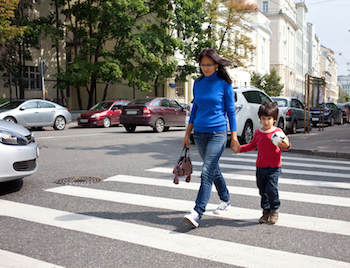Always watch out for pedestrians, slow down, prepare to stop and be extra careful especially in these areas:

- Where children are walking or playing.
- Where there are a lot of pedestrians walking or jogging alongside roads.
- Where pedestrians are walking or approaching a crosswalk.
- Near school zones, parks or residential areas.
Remember, your vehicle is like a heavy weapon and if you hit a pedestrian, you can cause serious injuries – or even death – which will have major consequences.
Drive slowly and cautiously near the school zone, parks and residential neighborhood or areas where children may be playing. Children do not have a good judgment when it comes to cars and can suddenly run across the street.
Sometimes if you are driving a big SUV, you may not see a child in your vehicle's blind spot, and this can be very dangerous. Be extra careful and courteous toward seniors, people on wheelchairs or with disabilities. Give them more time to cross the street because they are slow due to their disability. People with a hearing disability may not hear your car, and people who are blind rely on their hearing to become aware of you, so you need to be mindful of their disability and always provide a safe walking environment for them.
Always give the right of way to pedestrians
Below are some important rules regarding pedestrians:
- Always stop and give the right of way to pedestrians in a crosswalk.
- Watch out and prepare to stop for the nearby pedestrian who may walk into your path.
- Always stop and give the right of way to any pedestrian who walks on your path.
- When pedestrians are near your path or walking on the side of the street, use common sense, anticipate their actions, and be prepared to stop and give the right of way to them. Sometimes a pedestrian looks over and makes eye contact showing his/her need to cross the street; always give the right of way to pedestrians.
- If there are disabled pedestrians, older pedestrians or pedestrians with children that are crossing a crosswalk, give them more time to cross the street.
- Do not stop in a crosswalk because you will cause the pedestrians to walk outside the crosswalk and can put the pedestrians at the risk of getting hit.
- Do not pass a car that has stopped at a crosswalk because you may hit the pedestrian that you cannot see.
- Do not drive on a sidewalk, unless you need to use the sidewalk in order to enter or exit a driveway or an alley.
- Be aware that blind pedestrians rely on your vehicle's engine noise to make the decision of where to walk on a sidewalk, so you need to stay within 5 feet of the crosswalk in order for the blind pedestrians to be aware of your presence.
- If you are driving a hybrid or electric vehicle, be extra careful near pedestrians because these vehicles are silent while operating and the pedestrians may not hear them.
Pedestrians also have responsibilities
Just because the pedestrians have the right-of-way, it does not give them the right to act irresponsibly and put themselves and others at the risk of accidents. Pedestrians must also share the roads in a responsible manner.
These rules apply to pedestrians:
- Always use the crosswalk. Do not just run across the street where there is no crosswalk thinking that the approaching cars may slow down or stop to give you the right of way.
- If an intersection has a stop sign, you must wait at the curb and make sure the other vehicle are slowing down and seeing you before crossing the street.
- If an intersection has a stoplight, you must wait at the curb until the signal change to WALK before walking across the street. Even then, watch for cars that are trying to make the right turn and may act irresponsibly by not stopping.
- If you wear a dark clothes at night, be very careful when you are walking or bicycling outside the sidewalk. Most drivers will not be able to see you with dark clothes, which makes it a dangerous situation.
- Always walk on the sidewalk or crosswalk. If the road doesn't have sidewalks, walk on the edge of the road facing oncoming traffic; this way you and other drivers have a better chance of seeing one another and being able to react if a situation arises.
- If you are going to bike at night, wear reflective clothing and make sure your bicycle or helmet has a flashing light to warn the cars of your presence.
- While crossing the street, don't get distracted with your cell phone or other means of distraction; instead, pay attention to approaching cars and make sure they can see you and are stopping.
- If you are intoxicated, do not walk on roadways. Blurred vision and slow reaction time while you suddenly step onto a road leaves the driver with too little time to stop and avoid hitting you. You need to know that the oncoming drivers have the ability to yield before you enter the road.
- Never step into the street unless you are sure cars are able and willing to yield to you.
- Never walk or ride your bike, scooter, skateboard or any other slow moving conveyance on the freeways (Controlled Access Highways) or expressways (Limited Access Highways). Pedestrians are not allowed on those type of highways because they are not designed for that purpose.
